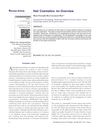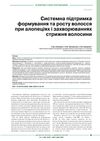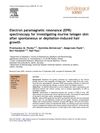TLDR Pulling 2 or fewer hairs is normal for all hair types, including Afro- and Asian-textured hair.
This study updated the hair-pull test guidelines to include individuals with Afro- and Asian-textured hair, involving 198 participants. It confirmed that pulling 2 or fewer hairs is considered normal across all hair textures, aligning with previous guidelines primarily based on Caucasian hair. The study found no significant impact of hair-care practices, such as washing or brushing, on the test results. Afro-textured hair showed more breakage due to its structural characteristics, but chemical treatments did not significantly alter the number of hairs removed. The study emphasized the need for consistent interpretation of the hair-pull test across different hair types.
16 citations
,
June 2017 in “PLoS ONE” A 6-group hair classification is more reliable for drug testing than an 8-group system.
 36 citations
,
December 2016 in “Journal of The American Academy of Dermatology”
36 citations
,
December 2016 in “Journal of The American Academy of Dermatology” The normal range for the hair pull test is 2 hairs or fewer, and washing or brushing hair before the test does not affect the results.
 193 citations
,
January 2015 in “International journal of trichology”
193 citations
,
January 2015 in “International journal of trichology” Dermatologists need to understand hair products to treat hair and scalp issues better.
55 citations
,
March 2007 in “Journal of cosmetic dermatology” Afro-ethnic hair can be straightened using chemical and heat methods.
 1 citations
,
January 2020 in “Дерматологія та венерологія”
1 citations
,
January 2020 in “Дерматологія та венерологія” Natubiotin is effective for treating different hair loss conditions when used with other therapies.
 22 citations
,
February 2008 in “Journal of Dermatological Science”
22 citations
,
February 2008 in “Journal of Dermatological Science” EPR spectroscopy showed that spontaneous hair growth results in thicker skin and less pigmented hair than depilation-induced growth.
July 1993 in “Journal of Radioanalytical and Nuclear Chemistry” Mouse hair element patterns vary, making it unreliable for tracking time.
1 citations
,
January 1987 in “PubMed” The treatment helped promote hair growth in men with androgenetic alopecia.
11 citations
,
February 1982 in “RePub (Erasmus University, Rotterdam)” Studying hair roots can help diagnose hair diseases and guide treatments.



